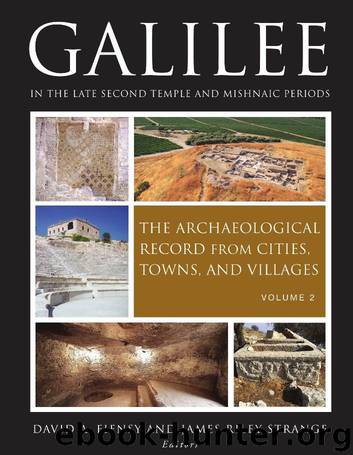Galilee in the Late Second Temple and Mishnaic Periods: The Archaeological Record from Cities, Towns, and Villages: 2 by David A. Fiensy

Author:David A. Fiensy
Language: eng
Format: azw
Publisher: Fortress Press
Published: 2015-10-31T16:00:00+00:00
Byzantine Capernaum (early 4th–early 7th cent. ce)
During the first half of the fourth century, Capernaum continued to experience the demographic decline that characterized the rest of the Galilee. Between 350 and 400 ce, however, the fate of Capernaum patently diverged from that of the rest of eastern Galilee, for Leibner’s survey indicates that the late fourth century was the most pronounced period of demographic decline.[93] This was surely in part due to the catastrophic earthquake of 363 ce, whose effects have left behind marked evidence in the archaeological record of such sites as Korazin, Hamam, Magdala, Sepphoris, and so on, and indeed also of Capernaum, where, for instance, evidence of collapse in Houses #8 and #5 was found.[94] Despite this, in contrast to most of the rest of the region, Capernaum appears to have enjoyed a substantial recovery precisely in the second half of the fourth century ce, for this is when the AANS of cooking ware recovered from the village reaches its peak (see fig. J.3). Even taking into account the fact that the Byzantine pottery is overrepresented in the village in comparison to that of earlier periods, it is clear that 350–400 ce was a time of demographic recovery in Capernaum. Indeed, the Capernaum data show evidence of refurbishment at this time. For instance, the central pillars of House #8 were reinforced.[95]
The enormous magnitude of the corresponding peak in the numismatic profile of stray finds in 350–400 ce (see fig. K), however, at first glance would seem patently quite out of proportion with the village’s surge in population during this same period (see fig. J.3). While the village’s population had grown from the end of its crisis period in the first half of the fourth century, it was not much larger—and indeed, perhaps even a bit smaller, given the fact that Byzantine pottery is overrepresented in comparison with that of the Roman period—than its earlier peak population in 200–270 ce. In striking contrast, the Average Annual Coin Loss in 348–400 ce, while varying from decade to decade, further averaged out over this approximately fifty-two-year period at over 12.5 times that of the earlier peak of 200–270 ce (see fig. K)!
In fact, however, this is precisely what one would expect, given that prices had increased roughly tenfold over those prior to the 260s–270s ce in the empire at large.[96] This inflationary spiral had given rise to important currency reforms that led to a radical increase in small change, not only at Capernaum but also throughout the region of Palestine (and indeed the eastern empire).[97] First, Diocletian (284–305 ce) created a single, empire-wide currency and a network of imperial mints that produced huge quantities of silver-clad bronze nummi. These Constantine and his successors continued to debase, both in silver content and in weight, so that after 348 ce, they had become so tiny that numismatists classify them as AE3 or AE4 types, the latter having had an average diameter smaller than that of a modern dime, with some having been considerably smaller.
Download
This site does not store any files on its server. We only index and link to content provided by other sites. Please contact the content providers to delete copyright contents if any and email us, we'll remove relevant links or contents immediately.
| Anthropology | Archaeology |
| Philosophy | Politics & Government |
| Social Sciences | Sociology |
| Women's Studies |
Mysteries by Colin Wilson(3394)
People of the Earth: An Introduction to World Prehistory by Dr. Brian Fagan & Nadia Durrani(2701)
Ancient Worlds by Michael Scott(2622)
Foreign Devils on the Silk Road: The Search for the Lost Treasures of Central Asia by Peter Hopkirk(2433)
The Splendid and the Vile by Erik Larson(2354)
The Memory Code by Lynne Kelly(2352)
Come, Tell Me How You Live by Mallowan Agatha Christie(2212)
Lost Technologies of Ancient Egypt by Christopher Dunn(2194)
The Earth Chronicles Handbook by Zecharia Sitchin(2179)
The Plantagenets by Dan Jones(2038)
Last Chance to See by Douglas Adams(1933)
The Return of the Gods by Erich von Daniken(1895)
Wars of the Anunnaki by Chris H. Hardy(1681)
Keeper of Genesis by Graham Hancock(1607)
Before the Dawn by Nicholas Wade(1575)
The Cygnus Mystery by Andrew Collins(1520)
The Message of the Sphinx by Graham Hancock(1482)
Fragile Lives by Stephen Westaby(1421)
Hieroglyphs: A Very Short Introduction by Penelope Wilson(1312)
